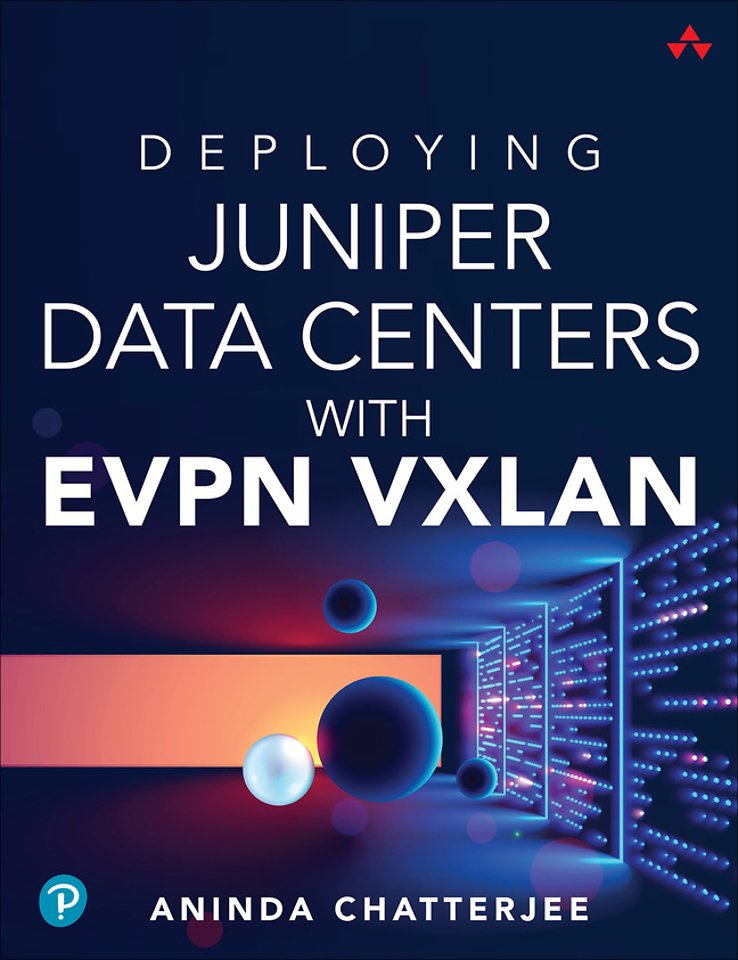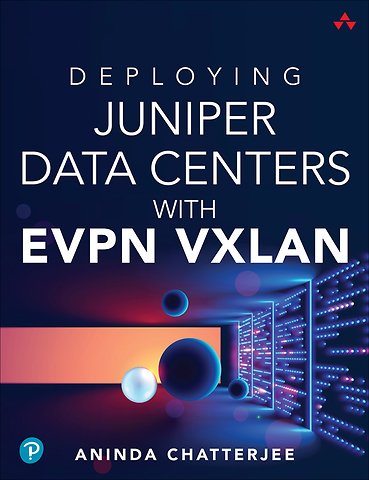<p>Introduction xvii<br> <strong>Chapter 1</strong> Introducing the Juniper Ecosystem 1<br> Junos Architecture 1<br> Building Layer 2 and Layer 3 Networks with Junos 3<br> Introducing the Junos CLI 4<br> Building a Network with Junos 11<br> Miscellaneous Junos Features 25<br> Rescue Configuration 25<br> Junos Copy Utility 26<br> Junos Groups 26<br> Junos Insert Utility 28<br> Summary 30<br> <strong>Chapter 2</strong> Overview of Data Center Architecture 31<br> History and Evolution of Data Centers 31<br> Data Center Designs and Overlay Architectures 37<br> 3-Stage Clos Fabric 37<br> 5-Stage Fabric 39<br> Collapsed Spine Design 40<br> Summary 41<br> <strong>Chapter 3</strong> BGP for the Data Center 43<br> BGP Path Hunting and ASN Scheme for Data Centers 44<br> Implementing BGP for the Underlay 49<br> Auto-Discovered BGP Neighbors 59<br> Summary 67<br> <strong>Chapter 4</strong> VXLAN as a Network Virtualization Overlay 69<br> Introducing VXLAN 70<br> EVPN for Data Center VXLAN Fabrics 75<br> Summary 79<br> <strong>Chapter 5</strong> Bridged Overlay in an EVPN VXLAN Fabric 81<br> Configuring and Validating a Bridged Overlay EVPN VXLAN Fabric 82<br> Configuring the Underlay 83<br> Configuring the Overlay 91<br> Packet Flow in a Bridged Overlay Fabric 97<br> Learning MAC Addresses and EVPN Type-2 Routes 101<br> High-Level Software Architecture for MAC Address Learning 101<br> Learning Local MAC Addresses 102<br> Learning Remote MAC Addresses 112<br> Proxy ARP and ARP Suppression 116<br> Replication of BUM Traffic and EVPN Type-3 Routes 120<br> EVPN Multihoming with ESI LAG and EVPN Type-1/Type-4 Routes 127<br> Configuring ESI LAG and EVPN Multihoming 129<br> MAC Address Synchronization Across ESI LAG VTEPs 132<br> EVPN Type-4 Routes and the Need for a Designated Forwarder 139<br> Aliasing, Fast Convergence, and Split Horizon with EVPN Type-1 Routes 147<br> Core Isolation in an EVPN VXLAN Fabric 157<br> Route Targets in an EVPN VXLAN Fabric 159<br> MAC Mobility 169<br> Loop Detection 173<br> Connectivity Fault Management 178<br> Loop Prevention Mechanism Using IETF Draft draft-snr-bess-evpn-loop-protect 181<br> Bidirectional Forwarding Detection in an EVPN VXLAN Fabric 182<br> Summary 188<br> <strong>Chapter 6</strong> MAC-VRFs 189<br> Introducing EVPN Service Types 189<br> VLAN-Based MAC-VRFs 191<br> Order of Operations with MAC-VRFs 200<br> Shared Tunnels with MAC-VRFs 201<br> VLAN-Aware MAC-VRFs 204<br> Overlapping VLANs, VLAN Translation, and VLAN Normalization 208<br> VLAN Translation 210<br> VLAN Normalization 214<br> Summary 223<br> <strong>Chapter 7</strong> Centrally Routed Bridging 225<br> Introducing Integrated Routing and Bridging and CRB Design 225<br> Configuring a Centrally Routed Bridging EVPN VXLAN Fabric 228<br> Validating and Understanding EVPN Route Exchange in a CRB Fabric 238<br> Importance of “Sticky” MACs for Virtual Gateway and IRB Addresses 250<br> Historical (and Present Day) Relevance of proxy-macip-advertisement 255<br> Packet Walk for Hosts in Different Subnets 263<br> Control Plane Flow 264<br> Data Plane Flow 271<br> Summary 277<br> <strong>Chapter 8</strong> Edge-Routed Bridging 279<br> Overview of Different Routing Models with Edge-Routed Bridging 279<br> Asymmetric IRB 283<br> Configuring and Validating Asymmetric IRB 283<br> Control Plane and Data Plane with Asymmetric IRB 291<br> Symmetric IRB 300<br> Configuring and Validating Symmetric IRB 300<br> Control Plane in a Symmetric IRB Design 304<br> Data Plane in a Symmetric IRB Design 313<br> Silent Hosts in a Symmetric IRB Design 319<br> Summary 323<br> <strong>Chapter 9</strong> Routed Overlay and Host-Routed Bridging 325<br> Overview of a Routed Overlay Design 325<br> Understanding EVPN Type-5 Routes and Their Use in Data Centers 326<br> Configuring and Validating Routed Overlay 329<br> Host-Routed Bridging 340<br> Summary 352<br> <strong>Chapter 10</strong> DHCP in EVPN VXLAN Fabrics 353<br> A DHCP Refresher 353<br> DHCP in a Bridged Overlay Fabric 355<br> DHCP in an Edge-Routed Bridging Fabric 361<br> DHCP Server in a Dedicated Services VRF 367<br> Summary 375<br> <strong>Chapter 11</strong> Data Center Interconnect 377<br> Introduction to DCI 377<br> Over-the-Top DCI 380<br> Integrated Interconnect with IP Transit 394<br> Stitching Two Bridged Overlay Data Centers via IP Transit 396<br> Stitching EVPN Type-2 Symmetric IRB Routes 415<br> Stitching EVPN Type-5 Routes 431<br> Integrated Interconnect with MPLS Transit 436<br> Control Plane Flow 442<br> Data Plane Flow 448<br> Summary 453<br> <strong>Chapter 12</strong> Building Data Centers with Juniper Apstra, Part I—Apstra Foundation 455<br> Introduction to Juniper Apstra 455<br> Building Blocks of Apstra 457<br> Onboarding Devices in Apstra 463<br> Zero Touch Provisioning 464<br> Manual Onboarding 475<br> Creating Rack Types and Templates 481<br> Creating Rack Types 482<br> Creating Templates 487<br> Deploying a Bridged Overlay 3-Stage Clos Fabric 489<br> Lifecycle of a Device in Juniper Apstra 515<br> Summary 516<br> <strong>Chapter 13</strong> Building Data Centers with Juniper Apstra, Part II—Advanced Apstra Deployments 517<br> Edge-Routed Bridging with Symmetric IRB 517<br> Data Center Interconnect with Juniper Apstra 530<br> Over-the-Top DCI 539<br> Adding an External Generic System 539<br> Creating Connectivity Templates 542<br> Configuring OTT DCI 552<br> Integrated Interconnect 558<br> Interconnect Domain and MSB for Auto-derivation of Interconnect ESI 560<br> Creating Remote BGP EVPN Peers 561<br> Extending IP VRFs and Virtual Networks 562<br> Configuring DC2 for Integrated Interconnect 569<br> Validating Integrated Interconnect 571<br> Summary 574<br> <strong>Chapter 14</strong> Building Virtual Fabrics with vJunos, Containerlab, and Juniper Apstra 575<br> Installing Containerlab and Building the vJunos-switch Image 575<br> Instantiating a Virtual Topology with vJunos-switch and Containerlab 579<br> Orchestrating a Virtual Fabric with Apstra 583<br> Summary 590<br> <strong>Chapter 15</strong> Large-Scale Fabrics, Inter-VRF Routing, and Security Policies in Apstra 591<br> Deploying a 5-Stage Clos Fabric 591<br> Inter-VRF Routing in Apstra Deployments 601<br> Deploying Security Policies in Apstra 618<br> Summary 629<br> <strong>Acronym Legend</strong> 631<br> <strong>Appendix A</strong> Quick Reference Guide 635<br> <br> <br> 9780138225391 TOC 3/28/2024</p>

